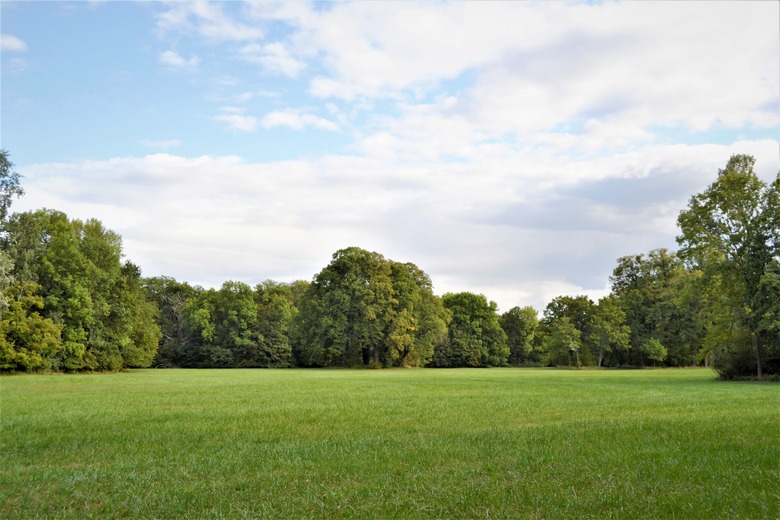What Is The Fastest Growing Grass Seed?
A lush lawn not only provides curb appeal and space for outdoor entertaining; it also improves the quality of soil by pulling nutrients to the surface and retaining water while holding soil in place and preventing erosion. As is often the case with a new home's construction, the yard consists of mere soil. Even an established lawn can suffer bare patches from pets that "do their business" in the same spots. Using a fast-growing grass seed can help to resolve these and other lawn problems.
Tip
There are several fast-growing grass species, including bermudagrass if you're looking for a warm-season grass and perennial ryegrass if you need a cool-season grass.
Choosing the Right Grass Seed
Select a grass seed suitable for your grass climate zone, or else your new grass may be fast-growing but fleeting. In the United States, grasses are assigned U.S. Department of Agriculture plant hardiness zones but also are classified as either warm- or cool-season grasses, a designation that reflects their season of active growth. USDA zones, however, generally coincide with grass climate zones in terms of general region.
Grass seed mixes often contain two or more grass species to increase the likelihood of successful seed germination, or sprouting, and growth in areas affected by a condition such as shade or heavy soil.
Cool- and Warm-Season Grasses
Warm-season grasses grow the most in summer, when temperatures are between 75 and 90 degrees Fahrenheit, and then go dormant in winter. These grasses, which thrive in the warm, humid regions of the southern United States, from the lower Atlantic Coast to southern California, include bermudagrass (Cynodon spp., USDA zones 7 through 10), centipedegrass (Eremochloa ophiuroides, USDA zones 7 through 9), zoysiagrass (Zoysia spp., USDA zones 5 through 10) and St. Augustinegrass (Stenotaphrum secundatum, USDA zones 8 through 10).
Cool-season grasses have active growth periods in early spring and early fall and grow best in regions that have cold winters and hot summers. Those areas include the Northeast, the Upper Midwest and the Pacific Northwest, including northern California. Cool-season grasses include perennial ryegrass (Lolium perenne, USDA zones 5 through 7), tall fescue (Lolium arundinaceum, formerly Festuca arundinacea, USDA zones 4 through 7) and Kentucky bluegrass (Poa pratensis, USDA zones 3 through 7).
Fastest-Growing Warm-Season Grass
Bermudagrass is the fastest-growing warm-season grass for lawns. Germination speed is greatly influenced by soil temperature, however. In fact, for bermudagrass seed germination to take place at all, the soil temperature must be higher than 70 F, which translates to daytime temperatures of at least 80 F. Given those temperatures, bermudagrass seed may germinate in as few as seven days. Under cooler temperatures, the seed can take 30 days or longer to germinate. In short, the warmer the temperature, the faster bermudagrass seed germinates.
Bermudagrass has a creeping habit facilitated by above-ground and underground "runners" that, unfortunately, also make this grass species potentially invasive when not managed properly. Edging on a regular basis will prevent its escape into flowerbeds and other areas.
Fastest-Growing Cool-Season Grass
Perennial ryegrass seed germinates in seven to 10 days, compared to 10 to 14 days for tall fescue seed and 14 to 21 days for Kentucky bluegrass seed. Perennial ryegrass is one of the cool-season grasses to grow to obtain a thick lawn turf quickly. It is often paired with Kentucky bluegrass seed in grass seed mixes to combine the fast growth habit of ryegrass with the spread of bluegrass.
To germinate and grow, perennial ryegrass needs a soil temperature between 50 and 65 F, which equates to daytime temperatures between 60 and 75 F. Because higher temperatures may cause perennial ryegrass to go dormant, fall is the ideal time to sow its seeds.
Success With Water
All grass seeds need sufficient moisture to germinate and grow. After sowing seeds, water the site every one to three days until germination occurs. Don't flood the seeds; just keep the top 1/2 inch of their soil consistently moist. After the seeds germinate, reduce watering to twice each week until the grass is well-established.
